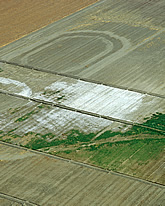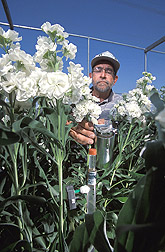This page has been archived and is being provided for reference purposes only. The page is no longer being updated, and therefore, links on the page may be invalid.
Conference Tackles Global Problem of Salinity
By Erin PeabodyApril 25, 2005
RIVERSIDE, Calif., Apr. 25—The International Salinity Forum that begins here today has drawn more than 200 scientists from 20 countries to discuss concerns about accumulating salts that threaten millions of acres of irrigated land around the globe. The three-day conference is sponsored by two USDA agencies—the Agricultural Research Service and the Natural Resources Conservation Service—together with the U.S. Bureau of Reclamation and the U.S. Bureau of Land Management.
"ARS efforts to find salt-tolerant crops that can use lower-quality drainage and sewage waters, including turf grasses for lawns and golf courses, will help conserve the region's vital fresh-water supplies and reduce threats to local aquatic and marine environments," said ARS Administrator Edward B. Knipling.
NRCS, the nation's private-lands conservation agency, uses ARS science and longstanding conservation expertise to help landowners control salinity and face other environmental challenges on their land.
"Enhancements to salinity resistance are very important to agricultural production and the protection of our natural resources," NRCS Chief Bruce Knight said. "Salinity is often called the 'silent killer' and with ARS science and NRCS technical expertise, landowners have the best available assessments and solutions."
Soil and water experts, many from the ARS George E. Brown Jr. Salinity Laboratory in Riverside, will present their latest research findings on how to best manage salt-stressed soils. Representatives from agricultural commodities impacted by salinity, such as cotton, wheat, rice and fresh produce, will also attend.
At the conference, Donald Suarez, director of the Riverside laboratory, will discuss how ARS-developed computer models can help water districts and irrigation consultants make informed decisions about salinity management. Other ARS researchers will discuss their technologies to effectively monitor and map soil salinity, as well as efforts to breed salt-tolerant crops that can thrive on recycled agricultural waters.
Irrigated fields, such as those in California's Central Valley, rely heavily on water that is conveyed hundreds of miles from its source. This water contains salts dissolved from the rocks and soils through which it passes before being stored in reservoirs.
When the water is used on cropland, it can leave behind salts and other potentially harmful trace elements, such as selenium and boron. Without adequate drainage, or with excessive irrigation, fields accumulate the damaging salts and can become toxic to many crop plants. In some cases, patches of white crust mark the fields that are most severely impacted.
USDA expects a result of the conference to be wider use of the best available science-based practices for salinity management.


